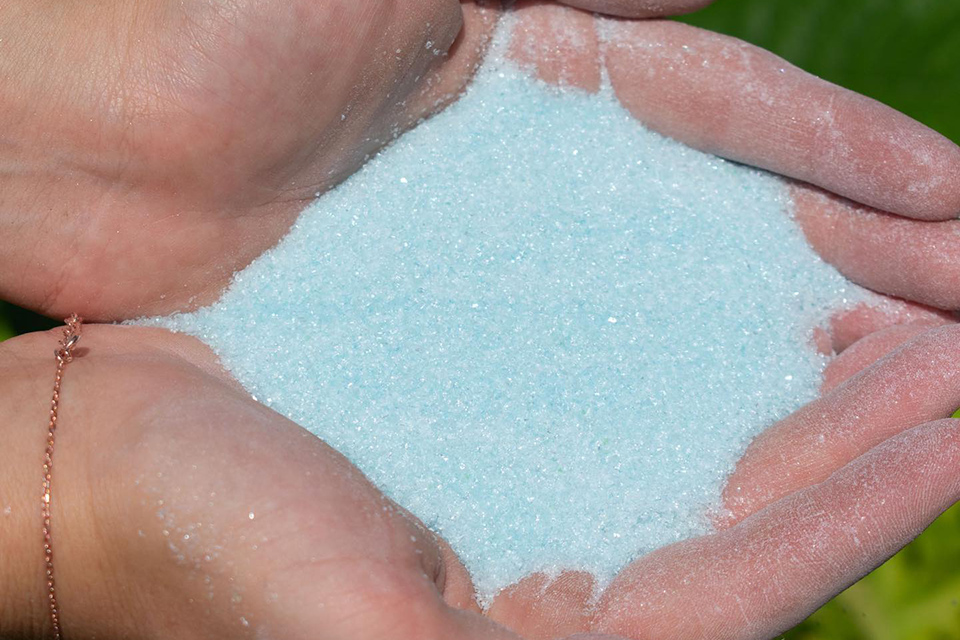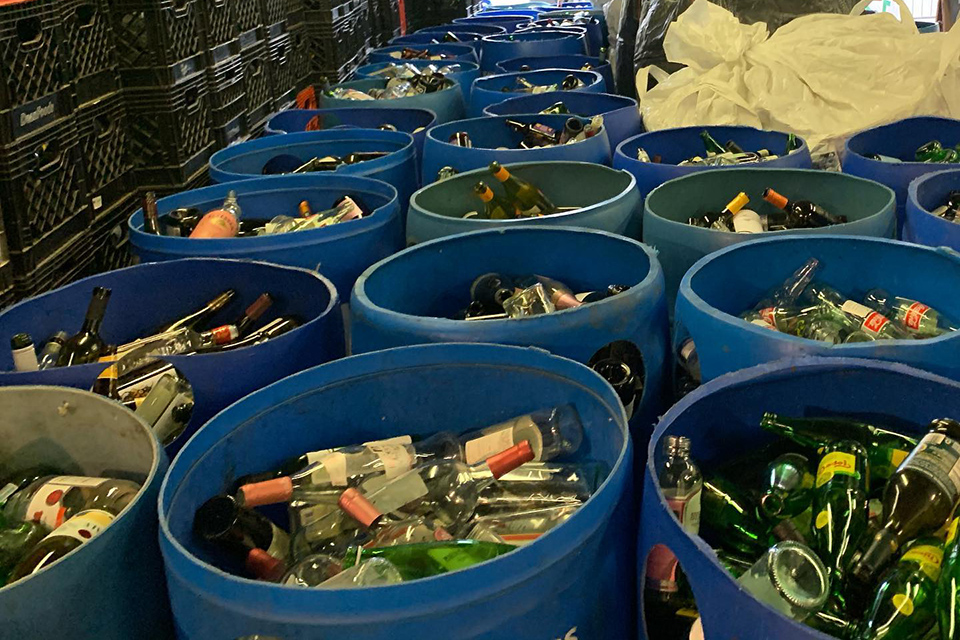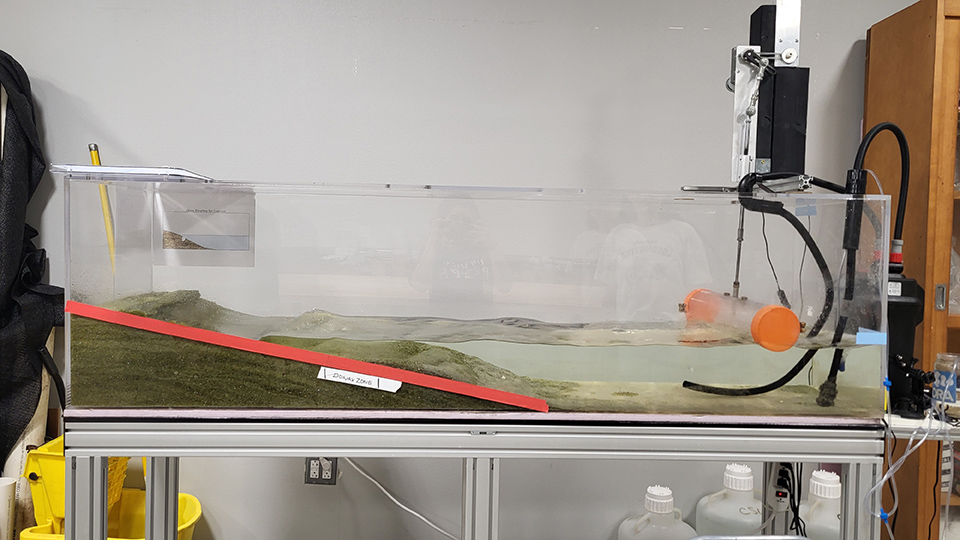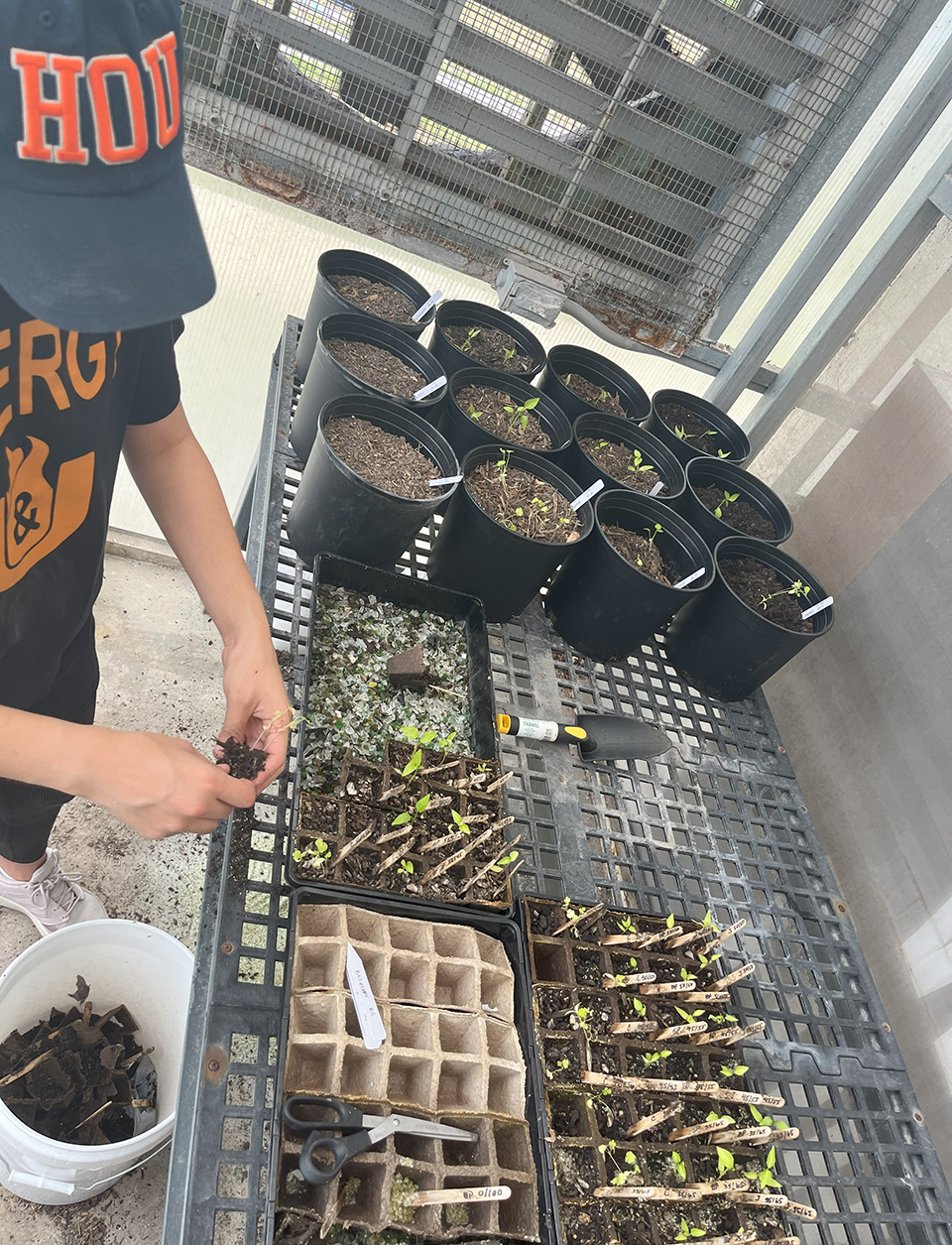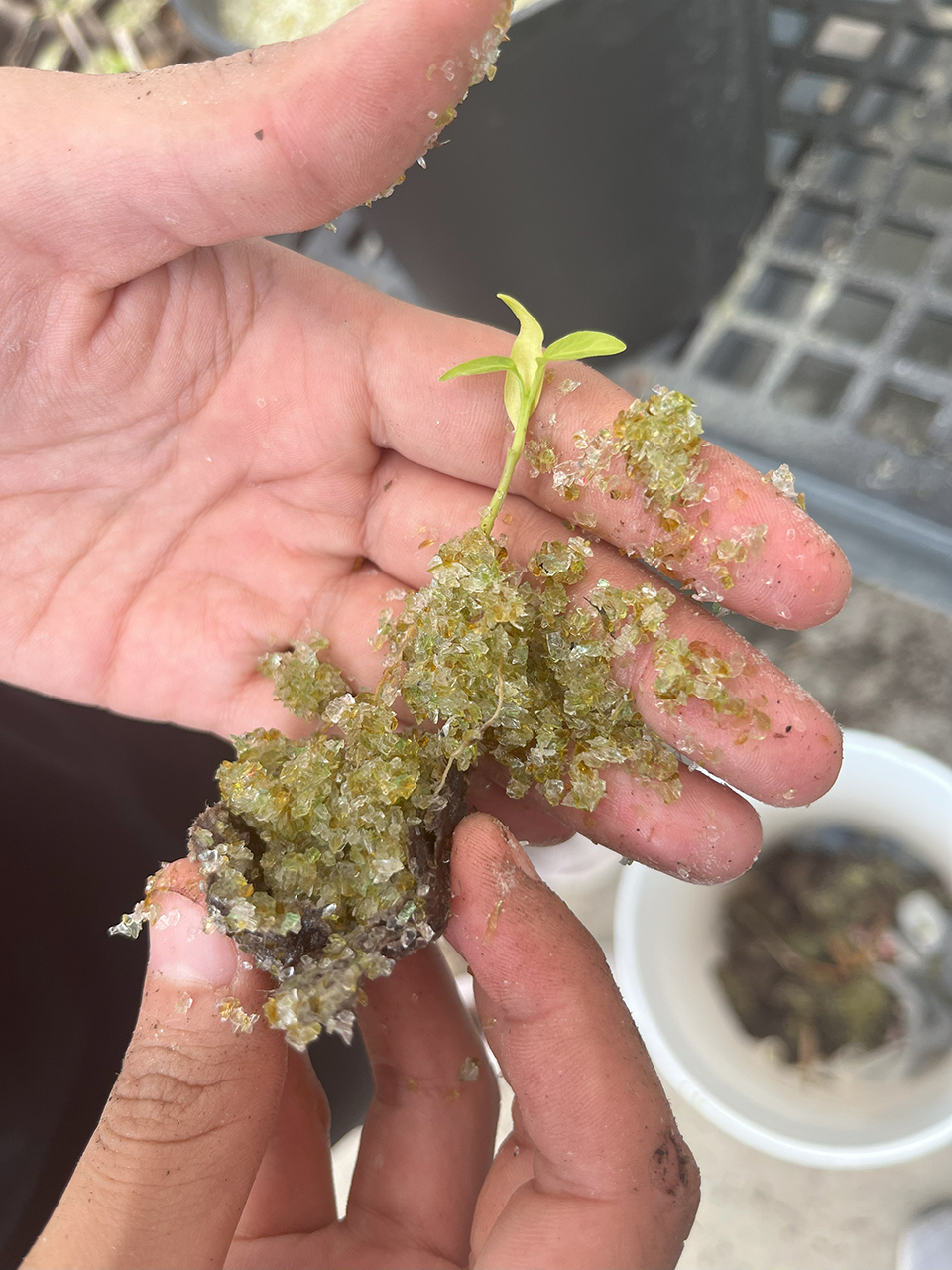By Amanda A. Taylor-Uchoa
RIO GRANDE VALLEY, TEXAS / NEW ORLEANS, LOUISIANA – AUG. 21, 2024 – Did you know that the glass bottle from your favorite drink could one day help preserve coastlines, or has the potential to grow crops?
At The University of Texas Rio Grande Valley, researchers are turning everyday glass waste into a possible innovative solution for coastal erosion and to be used in sustainable agriculture. The projects will not only transform recycled glass into a shield against the forces of nature, but also evaluates its potential as a novel agricultural medium – proving that your glass bottle’s next life might just be its most impactful yet.
These two separate initiatives aim to combat coastal erosion, particularly on South Padre Island (SPI), by utilizing the recycled glass sand as a sustainable alternative in beach nourishment and dune restoration efforts, and by investigating the use of recycled glass in agriculture for aiding in food disparities through the production of crops.
REVITALIZING COASTLINES WITH RECYCLED GLASS
Spearheaded by Dr. Julie Vanegas – an assistant professor in UTRGV’s College of Science and director of the Nanoworld Vanegas Lab, and in collaboration with the New Orleans-based ReCoast and Tulane University – the initiative delves into the core characteristics of recycled glass, assessing its viability for ecological restoration.
The collaboration traces back to foundational research at Tulane University, where Vanegas contributed significantly during her postdoctoral tenure.
Dr. Julie Albert, associate professor at Tulane and principal investigator on the NSF Convergence Accelerator Track E Award for Glass Recycling for Coastal Restoration, said the groundwork laid during the initial phases of the project at Tulane was instrumental.
“Professor Vanegas’ early work on glass sand composition and angularity was pivotal, and it was natural to keep her involved as we moved to Phase 2 of our research," Albert said.
She believes the seamless integration of the research could have broader environmental impacts in the future.
“Our collaboration has not only advanced our understanding of material science, but also positioned us to address crucial environmental issues through innovative uses of recycled materials," she said.
The lab's comprehensive studies – employing advanced elemental analyses such as X-ray fluorescence (XRF), X-ray diffraction (XRD), Scanning Electron Microscopy (SEM), and thermogravimetry (TGA) – are pivotal in ensuring the safety and effectiveness of recycled glass sand in environmental applications.
“We meticulously analyze the glass to determine its suitability for recycling,” Vanegas said. “For example, while older glass with contaminants like lead is unsuitable, newer, cleaner glass can be crucial in coastal restoration and even in cutting-edge nanoscience projects.”
The recycled glass sand helps combat erosion, providing a resilient barrier against storm surges and rising sea levels, as well as enhancing coastal ecosystems by contributing to their preservation and resilience.
Samantha Tamayo, who recently graduated from UTRGV with her Bachelor of Science degree in Biology and a research assistant in the Nanoworld Vanegas lab, said that working with recycled glass has made her realize the enormous impact of socioenvironmental issues glass waste has at a global level, like ocean acidification, land degradation, and species endangerment.
“Restoring the U.S. coasts with recycled glass sand is a good approach to diminish the effects this glass waste has in the first place while addressing erosion and dune degradation of our beaches, which work as defense against high-tides and storm surges,” Tamayo said.
“Since we are in the research phase of this project related to SPI, I hope that in a near future I can see our local beach in the restoring process; this would promote the importance of recycling, while envisioning the huge changes we can make in our community, encouraging students to be part in this type of research.”
MIXING INNOVATIVE AND TRADITIONAL MATERIALS
Dr. David Hicks, a professor in the UTRGV School of Earth, Environmental, and Marine Sciences (SEEMS), stresses the global relevance of this work.
“Erosion is a significant issue, especially with the ongoing threats of sea-level rise and climate change impacts,” Hicks said. “By innovatively using glass, essentially a form of sand, we are taking a proactive approach to mitigate erosion at South Padre Island, and potentially at other vulnerable coastal areas worldwide.”
While the implementation of recycled glass sand has not yet been tested at South Padre Island, testing is in progress to determine the feasibility of these type of endeavors in the future. Glass sand is not meant to replace naturally occurring sand, but it could help fortify it.
“Recycled glass sand likely will coexist with conventional methods for the foreseeable future,” Albert said. “There is not enough of it to replace all traditional materials. However, with strategic deployment, a little bit of sand can go a long way toward protecting and restoring the environment.”
The impacts of using glass sand are also being tested on marine life in the event the recycled glass is used on South Padre Island shores for erosion control and coastal restoration.
"So, we had to replicate a beach environment by making a wave tank,” Hicks said. “We put the glass sand into that wave tank, and we have introduced some of the ‘swash zone’ community, such as surf clams. We found that the surf clams were selecting a particular grain size of the glass sand in order to burrow in rather than occurring higher up on the beach."
The “swash zone” is an area of the beach where waves wash up and back down the shore, critical for various marine organisms that have adapted to the unique conditions of alternating wet and dry cycles.
Hicks said that while glass sand may have some initial differences (like sharper edges), it’s unlikely to harm larger organisms but could have unknown effects on smaller microorganisms.
Preliminary experiments have shown high survival rates for the organisms they studied.
POTENTIAL AGRICULTURAL INNOVATIONS
Beyond coastal conservation, the UTRGV side of the project also is investigating the use of recycled glass in agriculture, with researchers exploring the feasibility of glass sand as a substitute for soil in growing crops like cilantro, bell peppers and jalapeños. This novel approach not only addresses the global decline in arable land, but also enhances the sustainability of agricultural practices.
Being a nanomaterial scientist who had knowledge in the use of recycled glass for coastal erosion, Vanegas was paired with Dr. Teresa Patricia Feria Arroyo, a UTRGV professor in the School of Integrated Biology and Chemical Science and ecologist who researches food security and sustainability.
A pilot study was conducted showing that cilantro, bell pepper, and jalapeño plants can be successfully cultivated using recycled glass from pulverized bottles as a partial soil substitute. This innovative approach not only accelerates plant growth but also reduces unwanted fungal growth.
"Science should benefit people, and this research is giving us direct results that can impact food security,” Arroyo said. “If we can address food security issues in local settings – issues with global significance – then what we accomplish here can be replicated in many other places."
Vanegas and her team are closely monitoring the effects of glass sand on test crops currently being grown in buckets.
“Our crops are thriving, demonstrating that recycled glass can effectively support plant growth, potentially even more efficiently than traditional soil,” Vanegas said.
Vanegas stated the success underscores the potential of recycled glass to revolutionize agricultural methodologies, particularly in regions suffering from soil depletion or contamination.
A chemistry graduate student who works with Vanegas in the Nanoworld Vanegas lab, Andrea Quezada, presented the findings at the American Chemical Society (ACS) Fall 2024 meeting in Denver, Aug. 18-22. Quezada said she is most interested in the possibility of integrating glass-based soils into farming practices in the Rio Grande Valley and beyond.
The research could lead to sustainable agricultural practices that address both food security and environmental conservation, she said.
"I believe the conversion of a cyclic recyclable material, like glass, to a material with the same characteristics as sand will be profoundly impactful in the coming years,” Quezada said. “Sand plays a crucial role in human industrial development, but it is being depleted at a high rate. This research could serve as a strong foundation for future projects, advancing sustainable practices that target climate change and reduce landfill waste."
While the proactive initiative has not been assessed at local farms yet, the research team continues to conduct extensive evaluations on the performance, safety, and environmental impacts of using recycled glass as a growing medium. Their studies include assessing nutrient content, growth rates and overall plant health, and provide crucial data that could influence future agricultural practices around the world.
GETTING THE COMMUNITY INVOLVED
But the recycled glass project is not just about environmental research; it is also about community integration and educational outreach. Vanegas said UTRGV aims to establish a recycling plant in the future that will serve as a hub for community engagement and educational initiatives, promoting sustainability across the Rio Grande Valley.
“The broader vision is to launch a significant initiative here at UTRGV that not only supports recycling and sustainability, but also incorporates extensive educational programs for our students and the community,” she said.
That includes plans to apply for a $1 million grant to kickstart the recycling plant, setting a precedent for future blue economy initiatives – the sustainable use of ocean resources for economic growth – in the region.
The project’s reach is extending beyond local boundaries, with entities like the ACS expressing interest in the initiative for the pilot study on using recycled glass in agriculture and showcasing the research at the annual ACS Fall 2024 meeting.
“They sent out a press release about our agricultural findings with recycled glass, which could further spotlight our innovative approaches,” Vanegas said.
A SUSTAINABLE FUTURE IN SIGHT
As UTRGV continues to collaborate and expand on its glass sand research, the potential for its global impact grows. Ongoing developments in the project are paving the way for possible new methods of ecological conservation and food production, potentially setting new standards for sustainability practices worldwide.
Through the collaborative efforts of Vanegas, Hicks, Arroyo, and their research teams, along with the partnership with Tulane University, the research continues to help turn environmental challenges into opportunities for innovation and sustainability.
"It's not just about recycling glass; it's about creating a project that benefits the entire community,” Vanegas said. “We want to build something big here at UTRGV – something that not only addresses environmental issues, but also involves and empowers our students and the broader community."
ABOUT UTRGV
The University of Texas Rio Grande Valley (UTRGV) was created by the Texas Legislature in 2013 as the first major public university of the 21st century in Texas. This transformative initiative provided the opportunity to expand educational opportunities in the Rio Grande Valley, including a new School of Medicine, and made it possible for residents of the region to benefit from the Permanent University Fund – a public endowment contributing support to the University of Texas System and other institutions.
UTRGV has campuses and off-campus research and teaching sites throughout the Rio Grande Valley including in Boca Chica Beach, Brownsville (formerly The University of Texas at Brownsville campus), Edinburg (formerly The University of Texas-Pan American campus), Harlingen, McAllen, Port Isabel, Rio Grande City, and South Padre Island. UTRGV, a comprehensive academic institution, enrolled its first class in the fall of 2015, and the School of Medicine welcomed its first class in the summer of 2016.
